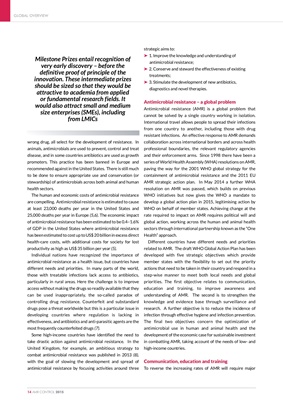
wrong drug, all select for the development of resistance. In
animals, antimicrobials are used to prevent, control and treat
disease, and in some countries antibiotics are used as growth
promoters. This practice has been banned in Europe and
recommended against in the United States. There is still much
to be done to ensure appropriate use and conservation (or
stewardship) of antimicrobials across both animal and human
health sectors.
The human and economic costs of antimicrobial resistance
are compelling. Antimicrobial resistance is estimated to cause
at least 23,000 deaths per year in the United States and
25,000 deaths per year in Europe (5,6). The economic impact
of antimicrobial resistance has been estimated to be 0.4-1.6%
of GDP in the United States where antimicrobial resistance
has been estimated to cost up to US$ 20 billion in excess direct
health-care costs, with additional costs for society for lost
productivity as high as US$ 35 billion per year (5).
Individual nations have recognized the importance of
antimicrobial resistance as a health issue, but countries have
different needs and priorities. In many parts of the world,
those with treatable infections lack access to antibiotics,
particularly in rural areas. Here the challenge is to improve
access without making the drugs so readily available that they
can be used inappropriately, the so-called paradox of
controlling drug resistance. Counterfeit and substandard
drugs pose a threat worldwide but this is a particular issue in
developing countries where regulation is lacking in
effectiveness, and antibiotics and anti-parasitic agents are the
most frequently counterfeited drugs (7).
Some high-income countries have identified the need to
take drastic action against antimicrobial resistance. In the
United Kingdom, for example, an ambitious strategy to
combat antimicrobial resistance was published in 2013 (8),
with the goal of slowing the development and spread of
antimicrobial resistance by focusing activities around three
strategic aims to:
‰ 1. Improve the knowledge and understanding of
antimicrobial resistance;
‰ 2. Conserve and steward the effectiveness of existing
treatments;
‰ 3. Stimulate the development of new antibiotics,
diagnostics and novel therapies.
Antimicrobial resistance - a global problem
Antimicrobial resistance (AMR) is a global problem that
cannot be solved by a single country working in isolation.
International travel allows people to spread their infections
from one country to another, including those with drug
resistant infections. An effective response to AMR demands
collaboration across international borders and across health
professional boundaries, the relevant regulatory agencies
and their enforcement arms. Since 1998 there have been a
series of World Health Assembly (WHA) resolutions on AMR,
paving the way for the 2001 WHO global strategy for the
containment of antimicrobial resistance and the 2011 EU
AMR strategic action plan. In May 2014 a further WHA
resolution on AMR was passed, which builds on previous
WHO initiatives but now gives the WHO a mandate to
develop a global action plan in 2015, legitimising action by
WHO on behalf of member states. Achieving change at the
rate required to impact on AMR requires political will and
global action, working across the human and animal health
sectors through international partnership known as the "One
Health" approach.
Different countries have different needs and priorities
related to AMR. The draft WHO Global Action Plan has been
developed with five strategic objectives which provide
member states with the flexibility to set out the priority
actions that need to be taken in their country and respond in a
step-wise manner to meet both local needs and global
priorities. The first objective relates to communication,
education and training, to improve awareness and
understanding of AMR. The second is to strengthen the
knowledge and evidence base through surveillance and
research. A further objective is to reduce the incidence of
infection through effective hygiene and infection prevention.
The final two objectives concern the optimization of
antimicrobial use in human and animal health and the
development of the economic case for sustainable investment
in combatting AMR, taking account of the needs of low- and
high-income countries.
Communication, education and training
To reverse the increasing rates of AMR will require major
GLOBAL OVERVIEW
14 AMR CONTROL 2015
Milestone Prizes entail recognition of
very early discovery - before the
definitive proof of principle of the
innovation. These intermediate prizes
should be sized so that they would be
attractive to academia from applied
or fundamental research fields. It
would also attract small and medium
size enterprises (SMEs), including
from LMICs